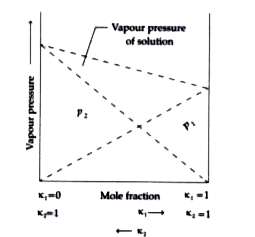In coparison to a 0.01 M solution of glucose, the depression in freezing point of a 0.01 M MgCl2 solution is……
the same
about twice
about three times
about six times
The correct Answer is:C
To determine the depression in freezing point of a 0.01 M solution of MgCl₂ in comparison to a 0.01 M solution of glucose, we will use the concept of the van 't Hoff factor (i) and the formula for freezing point depression.
1. Understand the Freezing Point Depression Formula:
The depression in freezing point (ΔTf) is given by the formula:
ΔTf=i⋅Kf⋅m
where:
- ΔTf = depression in freezing point
- i = van 't Hoff factor (number of particles the solute dissociates into)
- Kf = freezing point depression constant (depends on the solvent)
- m = molality of the solution
2. Determine the van 't Hoff Factor for Glucose:
Glucose (C₆H₁₂O₆) is a non-electrolyte, meaning it does not dissociate into ions in solution. Therefore, the van 't Hoff factor (i) for glucose is:
iglucose=1
3. Determine the van 't Hoff Factor for MgCl₂:
Magnesium chloride (MgCl₂) is an electrolyte and dissociates in water into three ions:
MgCl2→Mg2++2Cl−
Therefore, the total number of particles (ions) produced is 3. Hence, the van 't Hoff factor for MgCl₂ is:
iMgCl2=3
4. Calculate the Depression in Freezing Point for Each Solution:
Since both solutions have the same molality (0.01 M), we can express the depression in freezing point for both solutions:
- For glucose:
ΔTglucosef=1⋅Kf⋅0.01
- For MgCl₂:
ΔTMgCl2f=3⋅Kf⋅0.01
5. Compare the Depression in Freezing Points:
The depression in freezing point for the MgCl₂ solution is three times that of the glucose solution:
ΔTMgCl2f=3⋅ΔTglucosef
Conclusion:
The depression in freezing point of a 0.01 M MgCl₂ solution is 3 times that of a 0.01 M glucose solution.
The depression in freezing point (ΔTf) is given by the formula:
ΔTf=i⋅Kf⋅m
where:
- ΔTf = depression in freezing point
- i = van 't Hoff factor (number of particles the solute dissociates into)
- Kf = freezing point depression constant (depends on the solvent)
- m = molality of the solution
Glucose (C₆H₁₂O₆) is a non-electrolyte, meaning it does not dissociate into ions in solution. Therefore, the van 't Hoff factor (i) for glucose is:
iglucose=1
Magnesium chloride (MgCl₂) is an electrolyte and dissociates in water into three ions:
MgCl2→Mg2++2Cl−
Therefore, the total number of particles (ions) produced is 3. Hence, the van 't Hoff factor for MgCl₂ is:
iMgCl2=3
Since both solutions have the same molality (0.01 M), we can express the depression in freezing point for both solutions:
- For glucose:
ΔTglucosef=1⋅Kf⋅0.01
- For MgCl₂:
ΔTMgCl2f=3⋅Kf⋅0.01
The depression in freezing point for the MgCl₂ solution is three times that of the glucose solution:
ΔTMgCl2f=3⋅ΔTglucosef
The depression in freezing point of a 0.01 M MgCl₂ solution is 3 times that of a 0.01 M glucose solution.
Topper's Solved these Questions
Similar Questions
Knowledge Check
- Question 1 - Select One
In coparison to a 0.01 M solution of glucose, the depression in freezing point of a 0.01 M MgCl2 solution is……
Athe sameBabout twiceCabout three timesDabout six times - Question 2 - Select One
Read the passage given below and answer the following questions :
Raoult's law states that for a solution of volatile liquids, the partial vapour pressure of each component of the solution is directly proportional to its mole fraction present in solution. Dalton's law of partial pressure states that the total pressure Ptotal over the solution phase in the container will be the sum of the partial pressures of the components of the solution and is given as:
Ptotal= P1+ P2

In comparison to a 0.01 M solution of glucose, the depression in freezing point of a 0.01 M MgCl2 solution is _ ___Athe sameBabout twiceCabout three timesDabout six times - Question 3 - Select One
Assertion (A): 0.1M solution of glucose has same increment in freezing point than has 0.1M solution of urea.
Reason (R ): Kf for both has different value.AIf both (A) and (R) are correct, and (R) is the correct explanation of (A).BIf both (A) and (R) are correct, but (R) is not the correct explanation of (A).CIf (A) is correct, but (R) is incorrect.DIf (A) is correct, but (R) is correct.
Assertion (A): 0.1M solution of glucose has same increment in freezing point than has 0.1M solution of urea.
Reason (R ): Kf for both has different value.View Solutionof 0.01 M NaOH solution is
View Solution0.01 M solution each of urea, common salt and sodium sulphate are taken, the ratio of depression in freezing point of these solutions is
View Solutionof 0.1 M NaOH solution is
View Solution0.1 M aqueous solution of K4[Fe(CN)6] will have the same freezing point as 0.1 M aqueous solution of
View Solution

